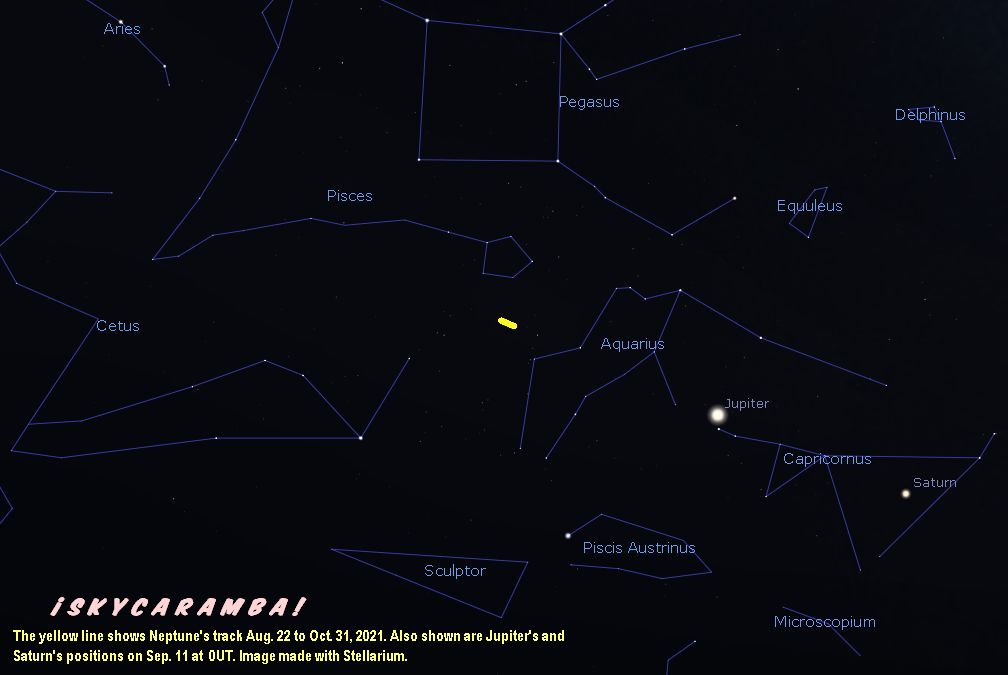This month, Mars is retreating from the evening sky into the sun’s light. Northern hemisphere sky watchers shouldn’t expect to see it. Southern hemisphere observers probably won’t see it either, but they have a slightly better chance.

Mercury is moving into the evening sky for the first half of the month. A waxing crescent moon passes somewhat nearby on the 9th. After greatest elongation at 26.8° east of the sun on the 14th, the messenger planet continues moving eastward against the background of stars (direct motion) toward Spica while its apparent separation from the sun shrinks. The planet settles into a position near Spica in the last few days of September.
Venus, also an evening object, starts the month near Spica and passes it on the 6th. The moon is close to Venus on the 10th. Passing near Zubenelgenubi around the 22nd, Venus enters the Libra diamond by the 26th. It’s almost out of the diamond on the 30th.
The best views of these evening setters will be from the southern hemisphere, especially from around 20° to 30° south.

Jupiter and Saturn are retrograde (going westward) in Capricornus this month. Jupiter is near Deneb Algedi all month and moving fast enough to see its position has changed if you watch every few nights. Saturn is west of Jupiter. The ringed planet’s motion slows down enough in the last few days of September to be called stationary in almanacs that still use the term. These two planets being in the constellation make September a great month to learn about the stars of Capricornus. The nearly full moon passes Saturn on the 17th and Jupiter on the 18th.


Neptune will be at opposition this month. You need a telescope or binoculars to see it. You also have to know exactly where to look. To make sure you’ve seen it, look several times this month and try to see that the faint blue dot has moved. It’ll be nearest a star labeled HIP115953, which is brighter than Neptune and is about 154 light years away. That star is actually at the limit of naked eye visibility for people with very good eyes and very dark skies. The two will be just 1.5′ apart on the 23rd and 24th. Neptune’s distance from us this month is about 4.326 billion kilometers.
Earth is at equinox on the 22nd at 19:22UT.
Notable conjunctions in September:
3rd Moon and Pollux 3.0°
5th Venus and Spica 1.6°
5th Moon and Regulus 4.5°
7th Mars and moon 3.8°
9th Mercury and moon 5.9°
9th Moon and Spica 5.3°
10th Venus and moon 3.7°
12th Ceres and Aldebaran 0.9°
13th Moon and Antares 4.1°
17th Moon and Saturn 3.7°
18th Moon and Jupiter 3.7°
20th Moon and Neptune 3.6°
21st Mercury and Spica 1.4°
24th Uranus and Moon 1.2°
26th Moon and Aldebaran 6.0°
30th Moon and Pollux 2.7°
The moon begins September in waning gibbous phase. It’s new on the 7th, first quarter on the 13th, full on the 20th, and last quarter on the 29th.
The moon is at northern lunistice at 25.9° on the 2nd, goes south of the equator on the 8th, reaches its southernmost at 26.0° on the 15th, crosses the equator northbound again on the 21st, and reaches a second northern lunistice this month on the 29th at 26.1°.
Lunar perigee is on the 11th at 368,500km. Apogee is on the 26th at 404,700km.
